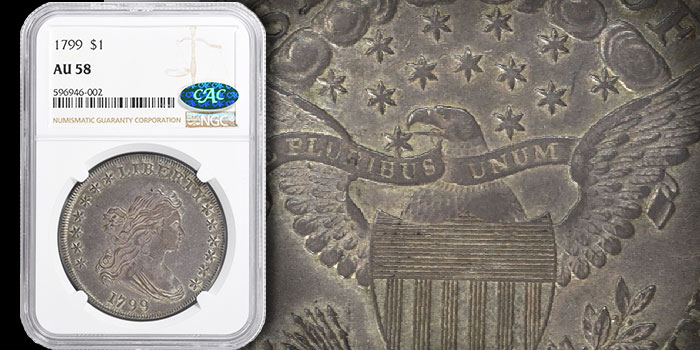
By CoinWeek ….
On Sunday, October 4, bidding ends at GreatCollections.com for this toned 1799 Draped Bust Heraldic Eagle Silver Dollar, graded AU-58 by NGC and approved by CAC.
NGC reports a total of 128 grading events at AU-58 for the 1799 Draped Bust dollar, which is clearly not the top pop grade. But this is in no way a knock on this coin since the solitary top pop MS-67 example last sold in 2013 for $822,500 USD, and the coin sells for six figures through MS-64 and five-figures through AU-58.
In 2019, an AU-58 specimen sold for $8,400 in April. In 2016, one example was sold for $7,637.50 in November and another was sold in May for $9,400. And years ago, an AU-58 went for $8,225 in July.
Going back a couple more years, however, and one sees a loose streak of five-figure prices that stretches back to 2005. Sticking to more recent records, however, we see prices like $10,868.75 in January 2013; $12,650 in February 2012 and August 2011; and $10,350 in May 2011 and December 2010. The highest price listed in NGC’s reckoning of auction results is $16,100, which took place in April 2008.
For more auction results, you can search through the GreatCollections Auction Archives, with records for over 600,000 certified coins the company has sold over the past seven years.
At the time of writing, the high bid on this 1799 Draped Bust silver dollar is $11,611 after 29 bids.
Background of the Draped Bust Heraldic Eagle Silver Dollar
The year 1795 was the second year of U.S. silver dollar production, and the coins produced were both the earlier Flowing Hair type and the newer Draped Bust type. The Draped Bust obverse was designed by United States Mint Chief Engraver Robert Scot, with Liberty said to be modeled after Philadelphia socialite Ann Willing Bingham. Mint Director Henry William DeSaussure (perhaps encouraged by President George Washington himself), in his quest to improve the designs of all U.S. coins but especially those made from silver, requested the design change. John Eckstein, a Rhode Island artist, made the plaster model of Stuart’s sketch from which Scot prepared the dies.
This portrait was used on the fractional copper and silver coins as well, but it first appeared on the dollar.
The first Draped Bust silver dollar reverse featured a small eagle like those on the first dollars produced in 1794. Apparently, as a result of criticism, Scot replaced the Small Eagle reverse in 1798 with a heraldic eagle modeled after the Great Seal of the United States. Being a transitional year for the series, coins of both reverse types were produced.
423,515 Draped Bust Heraldic Eagle silver dollars were struck dated 1799; this number includes the 1799/8 overstrike variety. Within the population of 1799/98 overstrikes, there are also 15-Star and 13-Star reverses.
Though the silver dollar was considered the primary coin of the U.S. monetary system, the large coins were often exported and melted as bullion, and few were seen in circulation from 1800 forward. Acknowledging this reality, President Thomas Jefferson halted production of the denomination after 1804, and none were produced until the introduction of Gobrecht’s Liberty Seated design in 1836.
Design
The obverse prominently displays Liberty in the center of the coin, long flowing hair swept backward and down her neck, and tied at the back with a ribbon. Folded drapery is placed across the bust and over her shoulder. Six-point stars, seven to the left of Liberty and six to the right; LIBERTY at the top; and the date at the bottom form a circle inside the denticled or beaded border.
The reverse has in the center a left-facing eagle, wings outstretched with the tips extending nearly to the denticled or beaded border. A shield covers most of the body, and the eagle holds in its beak a loop of a ribbon that displays E PLURIBUS UNUM, positioned in front of the right wing and in back of the left. The eagle’s right claw clutches several arrows, the left an olive branch. UNITED STATES OF AMERICA nearly circles inside the rim, the words separated by the eagle’s wing tips and tail. Above the eagle are 13 small six-point stars in two arcs, six at the top and five below, with an additional star on each side of the eagle’s head.
Some 1798 (possibly 1799 as well) issues have the stars arranged in two diamond-shaped groups of six each, the stars in straight lines, one group left and one right of the eagle’s head, and a single star in the middle. This arrangement is known as a cross pattern. Above the stars, below STATES OF is an arc of clouds. All coins were produced at the Philadelphia Mint and have neither mintmark nor denomination.
The edge features the lettering HUNDRED CENTS ONE DOLLAR OR UNIT, with decorative elements between the words.





Awesome thanks